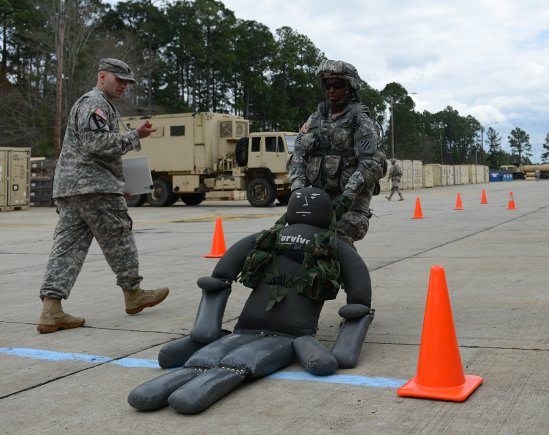FORT STEWART, Ga: In full gear, Sgt. Shawanna Washington moved ammunition, loaded mortar rounds into a gun tube, moved agilely as if under enemy fire, and completed other physically demanding tasks of a Soldier on the battlefield.
Washington completed the tasks as part of the Army’s Physical Demands Study. She was among 89 male and 58 female Soldiers of the 3rd Infantry Division who volunteered to take part in the study at Fort Stewart. Their job was to help the Army develop gender-neutral standards for infantry tasks.
Washington, who served a year-long and a 15-month-long deployment in Iraq, said she wants to be in the infantry. She signed up for the study, she said, to be a part of something bigger than herself and support the Army as it moves forward in opening combat jobs to women.
“I always dreamed of being an infantrywoman. I wanted to see exactly the experience and everything I learn from it while I go through the training,” she said, as she prepared to scale a six-foot wall during the testing.
The Physical Demands Study is part of Soldier 2020, the Army’s plan to integrate women into previously closed military occupational specialties in infantry, combat engineer, field artillery and armor military occupational specialties.
The Army’s Training and Doctrine Command, along with other research institutions, identified 31 common and physically demanding tasks in these military occupational specialties.
Other bases where the study has taken place include Fort Bragg, N.C.; Fort Bliss, Texas; Fort Hood, Texas; and Fort Sill, Okla.
The Physical Demands Study, which is distinct from the Army’s gender integration study, is assessing the strength, endurance, and power required to do combat arms tasks.
The 3rd Infantry Division Soldiers trained and prepared for a month. The testing was done the week of March 10.
Spc. Kendra Avery said she volunteered for the study to be a part of history as women are integrated into combat roles. She supports “100 percent” women serving in that greater capacity.
Although she does not plan on seeking a combat position, Avery said she took part in the survey to support women who want to enter those jobs.
“Looking back with my kids and grandkids, I can say, ‘I did this.’ If I can do it, anybody can,” she explained.
As part of the study, Soldiers donned oxygen masks and put on heart-rate monitors before carrying ammunition boxes weighing 45 pounds each. Army technicians recorded the data on laptops.
Other tasks over the test week included a road march; dragging a 270-pound dummy for 15 meters; moving a “casualty” out of a vehicle; and loading a TOW-2B Aero Missile into a ground mounted weapon system.
The purpose of the study is to develop gender-neutral physical standards to put the best Soldier — male or female — in the right job, according to Maj. Gen. John M. Murray, commanding general of the 3rd Infantry Division.
“We’re equally interested in what’s right for that Soldier, to give Soldiers the ability to be anything they want to be in the Army,” he said.
In addition, said Murray, the Army will have an opportunity to examine the physical conditioning of Soldiers, and how to avoid overuse injuries.
The study is being conducted in conjunction with U.S. Army Training and Doctrine Command, and the U.S. Army Research Institute of Environmental Medicine.
Edward Zambraski, division chief of U.S. Army Research Institute of Environmental Medicine Military Performance Division, is leading the research teams.
The goal of the study is to come up with predictive, physical performance tests that assess different elements of strength, endurance and coordination, Zambraski said.
“The whole idea of this physical standards study is to develop some tests so essentially we pair the person with the correct skills and attributes to those demands, so there is less chance of that Soldier being hurt,” he said.
“If we can do that, we’ve achieved a major milestone for the Army,” he said.
He said the Army began the testing last year and has three years to complete the study.










